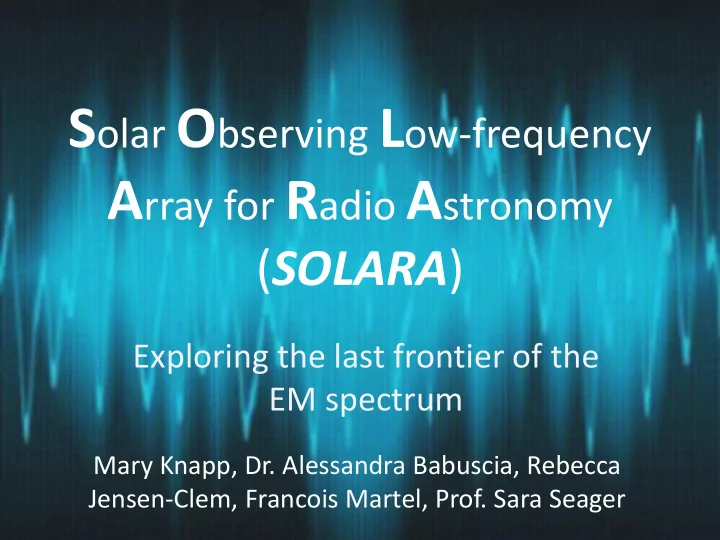

S olar O bserving L ow-frequency A rray for R adio A stronomy ( SOLARA ) Exploring the last frontier of the EM spectrum Mary Knapp, Dr. Alessandra Babuscia, Rebecca Jensen-Clem, Francois Martel, Prof. Sara Seager
What’s missing? The advent of large radio receivers opened a new window on the sky Infrared observations drew back the dust curtain shrouding the Milky Way From the beginning of astronomy to recent times, only light visible to the human eye could be observed Larger dishes and interferometry extended radio astronomy to longer wavelengths Modern detectors image high-energy phenomena Image Credit: NASA Image Credit: NASA
Ultra Low Frequency Observations • Ionosphere blocks/reflects wavelengths below ~10 MHz Space-based observatory • Long wavelengths require large apertures for angular resolution ( θ = λ /D) • Monolithic apertures are impractical INTERFEROMETRY (sparse aperture) • Interferometer baseline measurement requirements easier at long wavelengths ( μ ~ λ /10 ) • Solution: CubeSat interferometer in space
Astronomy at long wavelengths: Coronal Mass Ejections (CMEs) • Danger to spacecraft, astronauts, and terrestrial power grids • SOLARA can track CMEs in 3D by monitoring radio bursts generated by shock waves • Type of radio burst indicates how dangerous a solar storm will be to Earth Image Credit: NASA/ESA
Astronomy at long wavelengths: Giant Planet Magnetospheres • 5 planets with strong magnetic fields in the solar system: Earth, Jupiter, Saturn, Uranus, Neptune • No spatially resolved imaging of radio sources below ionospheric cut-off • Voyager s (launched 1973) were first and last to study long wavelength radio emissions from all giant planets Ionospheric Cut-Off 13 cm (2.3 GHz) 22 cm (1.4 GHz) Image credit: CSIRO Figure credit: Piso et. al, 2011
CubeSat Implementation
Radio Science Instrument • 2 deployable “active” BeCu dipole antennas (6 m) orthogonal to each other • Low-noise amplifier • Payload and Telemetry System (PTS): customized radio receiver – FPGA-based – 1 Hz frequency tuning – Bandwidths from 1 kHz to 10 MHz Stored Tubular – Optimized for 100 kHz to 10 Extendible Member MHz (STEM) deployable antenna (Northrop- Grumman)
Interferometry Present: Ground-based, central correlator • Aperture synthesis interferometry • Distributed correlator – Very Large no central hub Array (VLA), New Mexico, • 190 unique baselines (20 UHF Radio Telescope at Fuji Station USA spacecraft • Array will grow over time, increasing angular resolution SOLARA: • 1 – 60 arcminutes @ space-based, 1 MHz distributed correlation
Formation Flight (Lite) • Relaxed metrology requirements – accurate baseline measurement necessary, but NOT control • “Beginner” formation flight – only occasional corrections/adjustments required, not constant formation maintenance (open loop) • Intersatellite ranging: SARA (S-band) • Constellation orientation - aggregated star tracker measurements
Communication: SARA • S eparated A ntennas R econfigurable A rray ( SARA ) will use the SOLARA constellation as a platform to test the technology of MIMO systems in space. • Key idea : multiple antennas opportunely aggregated to form a highly directional array by combining signals in phase. • 2 S-Band channels for each spacecraft: – One for Earth communication – One for inter-satellite links • Master-slave configuration – Comm to Earth (time, data) coordinated by master – Intersatellite clocks and ranges exchanged frequently • SARA gain: 23 dB, 57 kpbs from LL1 vs. CubeSat gain: 6dB, 2.4 kbps from LL1
Propulsion: Electrospray Patch Thrusters • High voltage grids ( 1-2 kV ) accelerate ions to provide thrust • Small footprint (1 cm 2 ) • Ionic liquid propellant: Electrospray thrusters developed by Prof. – No vapor pressure Paulo Lozano of MIT’s Space Propulsion Lab – No pressure vessels or plumbing – No combustion • High Isp ( ~3500 ), low propellant mass • ~ 1 μ N per thruster • Thrusters will be tested in precursor missions Images adapted from Lozano & Courtney, 2010
Carrier Vehicle – GTO to LL1 transfer • Transports Multi-payload Utility SOLARA/SARA CubeSats Lite Electric (MULE) by ULA/Busek to LL1 destination Your • Radiation protection payload while in transit here • High gain communications • Back-up central hub for array SOLARA CubeSats
Journey to LL 1 Initial Geostationary Transfer Orbit (GTO) Expanding Elliptical Orbits (~3 months) Injection into Lissajous Earth-Moon orbit about LL1 Lagrange Points LL 1
Subsystems • ADCS – thrusters are actuators, star tracker, sun sensors, gyros provide attitude estimate • Power – deployable solar wings provide 30 W power. Orbit allows near-continuous sunlight • Avionics – ARM7-based flight computer will provide ADCS calculations and housekeeping • Structure – custom 6U structure manufactured from aluminum • Thermal – LL1 orbit and sun-pointing solar panels provides a stable thermal environment. Antisun- facing spacecraft sides used as radiators
Strategy and Schedule • Three-phase implementation: – Phase 1: Thruster demonstration precursor mission - 2014 – Phase 2: Science payload demonstration in LEO (2-3 CubeSats) – 2015-2017 – Phase 3: Full array launch and deployment in LL1 – 2018-2020
Conclusions Ambitious but feasible – high risk, high reward Precursor missions reduce risk and raise TRL of novel technologies Full redundancy – no single point of failure, tolerant to CubeSat losses Convergence of technologies to make SOLARA/SARA possible – paradigm shift • Existing Technologies : • Novel/developing Technologies: – Deployable STEM antennas – SARA – S-band inter-satellite ranging (PRISMA) – Electrospray thrusters – CubeSat star tracker – PTS (radio science receiver) – ADS sensor-enabled solar panels – FPGA-based correlation – Multi-CubeSat delivery
Acknowledgements Prof. Sara Seager (MIT) Dr. Dayton L. Jones (JPL) Courtney Duncan (JPL) This work references NASA proposals for the ALFA and SIRA missions
Back-Up Slides
Frequency Wavelength θ @ 10 km θ @ 100 km θ @ 1000 θ @ 10,000 km km 30 MHz 10 m 3.4’ 20.63” 2.06” 0.2” 10 MHz 30 m 10.31’ 1’ 6.19” 0.62” 1 MHz 300 m 1.719° 10.31’ 1’ 6.19” 100 kHz 3000 m 17.19° 1.719° 10.31’ 1’ 30 kHz 10,000 m 57.29° 5.73° 34.38’ 3.43’
CubeSat Implementation
Recommend
More recommend